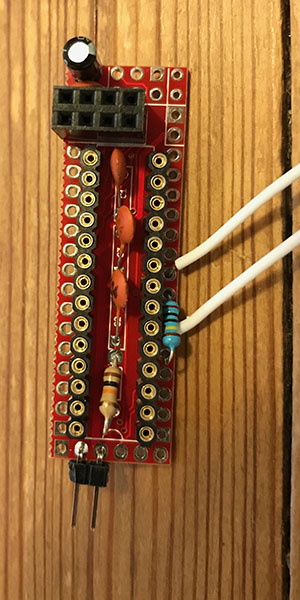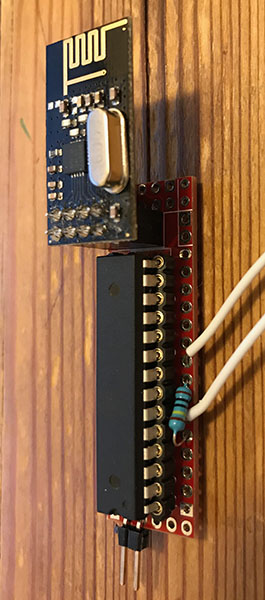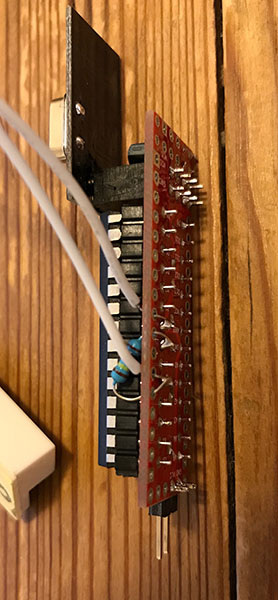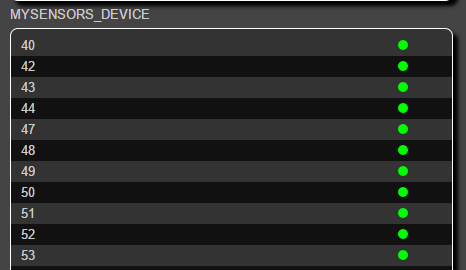My Slim 2AA Battery Node
-
@m26872
thanks again for this great idea and that you developed these fine boards !
And by the way...
As you are using fhem as well...
How do you manage to reset the tripped "1" in Fhem ?
I just added a delay and a gw.send"0" to your sketch :), but using fhem would be more sophisticated actually ...
Thanks -
@m26872
thanks again for this great idea and that you developed these fine boards !
And by the way...
As you are using fhem as well...
How do you manage to reset the tripped "1" in Fhem ?
I just added a delay and a gw.send"0" to your sketch :), but using fhem would be more sophisticated actually ...
Thanks@Komaandy said in My Slim 2AA Battery Node:
How do you manage to reset the tripped "1" in Fhem ?
I don't. I just use the last trip time as it's state and then notify (e.g. light or push message) on trip. I think it should be very simple to make a notify with a timer "at" to reset it after a while, if you wish.
-
All of the ducting near me is a bit too slim to fit sensors based on this, so I decided to design and print a case instead.
Does the trick nicely, and I also chose to use proper AA battery clips to retain a good connection, as the cable-tie battery assembly wasn't holding well for me!
On the Thingiverse page I have a link to the original OnShape doc.
https://www.thingiverse.com/thing:2418194

Thoughts, suggestions, etc will be much appreciated!
-
Hi
Did anyone make DHT 22 slim node with MySensors 2.0? I created one Node from modified MySenors 2 example...But I get a feeling that it is freezing sometimes (but then again comes back to life).
-
Hi
Did anyone make DHT 22 slim node with MySensors 2.0? I created one Node from modified MySenors 2 example...But I get a feeling that it is freezing sometimes (but then again comes back to life).
@Oliviakrk - I did a test (which works pretty ok) with a DC/DC step up booster attached to D3 -> Vin. This way I could turn the booster on/off with HIGH/LOW from the sketch. This provided 3.3v to my sensors just fine and has been working for a while now. I dont know what will happen when the voltage drops though.
-
@Oliviakrk - I did a test (which works pretty ok) with a DC/DC step up booster attached to D3 -> Vin. This way I could turn the booster on/off with HIGH/LOW from the sketch. This provided 3.3v to my sensors just fine and has been working for a while now. I dont know what will happen when the voltage drops though.
@sundberg84 Thanks. Will try.
-
Hi,
Thank you for all the hard work put into this project. I have built a few door sensor nodes and have some issues. At first I had pull-ups connected as shown in previous pictures but at a logic 1, when there should have been 3.3V there was only roughly half, 1.7V. I am no expert but I take it there has to be a current leak through the D3 pin for this to happen. I have this on all my nodes. I have tried different code but still the same. When I remove the external pull-up the node works properly but instead the batteries run out in a week or so. Have I made a mistake soldering these and maybe shorted something? I have looked at them closely but can't see anything wrong.Does anyone else have this problem? Any tips?
-
If I disconnect the battery, there is continuity between D3 and VCC with a resistance of around 20 kOhm. So when the door sensor is shut (no resistance), I connect GND through 20 kOhm to VCC. The current should be 0,165 mA. Too high by reading previous posts but still much less than what I get if I measure. Then I get roughly 18 mA! (Far from a Fluke though but has proven reliable before). Am I misunderstanding things?
I have tried different nodes and sketches with pull-ups both enabled and disabled but I doesn't seem to matter. I have tried different radio modules but still the same, unless I use the bigger! antenna-version. Then the current goes up to 24-25 mA.
I have done/am doing something really wrong although they seem to work just fine. Tomorrow I will try more radio modules to see if I can find any difference.




-
If I disconnect the battery, there is continuity between D3 and VCC with a resistance of around 20 kOhm. So when the door sensor is shut (no resistance), I connect GND through 20 kOhm to VCC. The current should be 0,165 mA. Too high by reading previous posts but still much less than what I get if I measure. Then I get roughly 18 mA! (Far from a Fluke though but has proven reliable before). Am I misunderstanding things?
I have tried different nodes and sketches with pull-ups both enabled and disabled but I doesn't seem to matter. I have tried different radio modules but still the same, unless I use the bigger! antenna-version. Then the current goes up to 24-25 mA.
I have done/am doing something really wrong although they seem to work just fine. Tomorrow I will try more radio modules to see if I can find any difference.




@masfak97 It's not clear to me whether you've tried to run it a as pure Arduino, without radio module and without MySensors library in your sketch? (I see that you haven't the serial/FTDI pins soldered - do you use ICSP, pogo-pins or whatever to upload and debug?)
-
I have thought about running it as a pure arduino and to use the debug function, but can't quite get the FTDI to work. I have used this before to upload code to arduino pros. I have a previous node that has all the pins soldered but simply won't be recognized with the USB FTDI. I have also tried switching USB-FTDI but still no luck. Is the FTDI supposed to work if all the pins are there?
I have also bought a USBtinyISP but haven't read up on how to use it.
Currently I install a first boot loader with Nick Gammons sketch running on a UNO connected to a breadboard and the 328. After that has been installed, I install the 8 MHz boot loader by Gert Sanders (thank you of it) and finally upload the code using "Upload using programmer". I currently have no way of reading the serial debug from the node.
I checked the node without the nrf but still power-hungry in the mA.
-
I think you should focus on getting these basic Arduino functions working so you're in control of what's going on. Note that I recently added a few updates to the first post of this thread (under The uC - Software). Read the tutorials and use 8MHz internal clock.
When you get everything running, test your door switch again with a simple Arduino sketch. -
I think you should focus on getting these basic Arduino functions working so you're in control of what's going on. Note that I recently added a few updates to the first post of this thread (under The uC - Software). Read the tutorials and use 8MHz internal clock.
When you get everything running, test your door switch again with a simple Arduino sketch.@m26872
UPDATE 2: There have been reported issues with MySensors 2.x freezing on SlimNodes running at 1MHz, which I've confirmed. Recommended solution when using MyS 2.x, is to use 8MHz (internal) instead.This I can confirm - running at 1 MHz introduced some real oddities with latest MySensors library. Not sure what changed but my nodes definitely freaked out. Will try switching to 8 MHz - hopefully before Irma whacks us here.
-
@m26872
UPDATE 2: There have been reported issues with MySensors 2.x freezing on SlimNodes running at 1MHz, which I've confirmed. Recommended solution when using MyS 2.x, is to use 8MHz (internal) instead.This I can confirm - running at 1 MHz introduced some real oddities with latest MySensors library. Not sure what changed but my nodes definitely freaked out. Will try switching to 8 MHz - hopefully before Irma whacks us here.
-
@wergeld
Same confirmation from my side; 1mhz boot loader doesn't work; dht22 with step up connected does always give NAN. Switching to 8mhz boot loader did the trick.
//@2.2.0-beta -
@kotzer Thanks for sharing. But (AFAIK) the Arduino DHT22 library has never worked at all at 1MHz. And since dht22 doesn't support <3V there's no need for 1MHz anyway.
@m26872
Maybe offtopic, sry, but:
I have Step up at dht22, so it has 3,3v to operate..But I am in wrong topic, it should be your first 2aa sensor ( https://forum.mysensors.org/topic/486/my-2aa-battery-sensor )
This is what I built, and with 1mhz it doesn't work (tried with step up 3,3v and without) this wasted me many hours, because I wanted to save energy as much possible ;) with 8mhz its operating well.
Greets from Germany

